December, 2022: In this interview with John Reardon, Peter Friess the curator of the Patek Philippe Museum discusses the challenge of selecting a sample of timepieces that best summarize 500 years of European horological history from the museum’s extensive and superlative collection. Read on to learn more about the careful compilation and design of this must-have publication for anyone with an interest in watches.
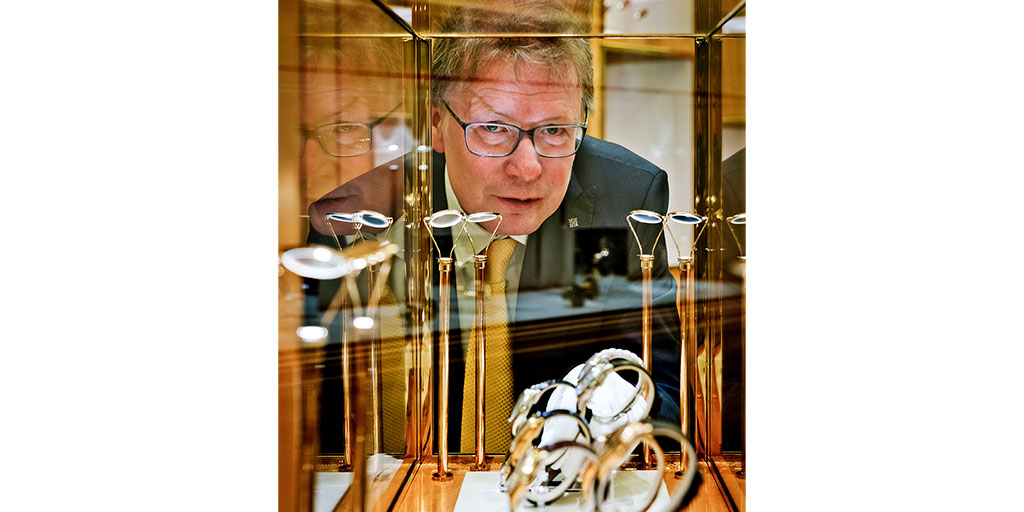
JR: To begin, can you tell us why there is a new book from the Patek Philippe Museum?
PFR: In recent years, the Patek Philippe Museum began to place much greater emphasis on reaching the general public, by telling stories about time and timekeeping. I felt this was a powerful way to bring the objects to life. Each of our two new books tells 20 stories, based upon our two major exhibitions, the Antique Collection and the Patek Philippe Collection. Together they deliver two key messages. First, that watchmaking is a great European success-story and, Secondly, that, with Patek Philippe’s invention of the key winding and setting mechanism in its early days (see image below), the company rose almost immediately to top tier of the watchmaking industry.

It took advantage of that position to become the most prestigious manufacturer of the most sophisticated watches in the world. Our two newly-minted books allow you to take our exhibitions home with you, or, alternatively, to get a preview of our treasures before you visit. While the books are not large — only 104 pages each — they serve a very important purpose. They succinctly summarize 500 years of European horological science, craftsmanship, and art. A theme that helps tie all this together is the quest for what we call the“perfect watch,” as I will explain later.
JR: Who is the publisher and why did you select them?
PFR: Our Germany-based publisher, teNeues, has a global reach, which is one of the main reasons we selected them. Here is a link highlighting the book.
JR: It is one of the most lavishly designed and presented museum books I have ever seen. Presented in a slip case, this two-volume set seems to be an incredible value at USD75. How did you decide what price to offer this book set? How many copies will there be?
PFR: Lavish as they are, the books are just an appetizer for a visit to the museum itself. And after your visit, they lock in your memories of the experience and allow you to share them with friends and family back home. The price tag of 50 Euros for, not one, but both volumes in a slipcase is indeed quite modest, especially considering the superior quality of what you get. Of course, the price differs slightly if acquired outside of Switzerland or Germany. Our first print run is 15,000 copies. We expect a level of customer demand that will soon set our printing machines back in motion. Mr. Philippe Stern, our Honorary President, wanted these books, which showcase most of our greatest treasures, to sell at a fair price which offers access to as many people as possible. Our main purpose is to make our collections and exhibitions known around the globe.
JR: I understand 240 watches were chosen from the museum to be highlighted in this two volume set. How did you decide what watches to include?
PFR: This takes me back to my statements about how the museum has evolved. Very simply, we selected watches that support our story lines. Philippe Stern was deeply involved in the selection process. I vividly remember the conversations we had in making the difficult decision about which timepieces to include — a mere 10 percent of what is on display in the museum. I truly believe every one of our watches is worthy of being in the books, so you can imagine how tough it was for us to make the cut. Again, we were guided by the stories we wanted to tell.
JR: Looking through the pages, I see timelines are integrated into the presentation of each chapter. It truly helps put the historical and horological context in place for each watch. Can you tell us more about why you chose to do this?
PFR: Originally—when the museum was founded 22 years ago—all the watches were presented in the order of their manufacture, from the earliest to the most recent. Today the Antique Collection and the Patek Philippe Collection are each divided into 20 subject areas. Each exhibit area is assigned to a period and matched by a chapter in the book. The book designer came up with the idea to visualize the periods in a timeline. I developed this ordering concept some years ago with Dr. Arthur Molella, from the Smithsonian Institution in Washington D.C. We reorganized the museum according to this scheme. This approach allows us to focus on particular subjects, such as the perpetual calendar or the minute repeater or the world timer. We explain in greater detail every one of our 297 showcases in our iPad “Tour Guides.”
JR: The photography is unlike anything I have seen before that it appears to have been shot by someone that knows the horological importance of every watch and more importantly every part of the watch. It almost seems like each watch was shot by a watchmaker that knew exactly what he wanted to show. Can you comment on this? Who was the photographer? Is this new photography for the book?
PFR: For some years, one of the world’s foremost watch photographers, Fabien Cruchon — an expert in a fascinating professional sub-specialty — has been making images of our timepieces, always using the most cutting-edge technology. Cameras and lenses are constantly improving so much that about every two years you have to update your equipment, both hardware and software. The photos he takes have incredible depth of field, every detail is in perfect focus. It’s unbelievable, but it sometimes takes 60 shots to assemble just one image such as the spectacular image below:
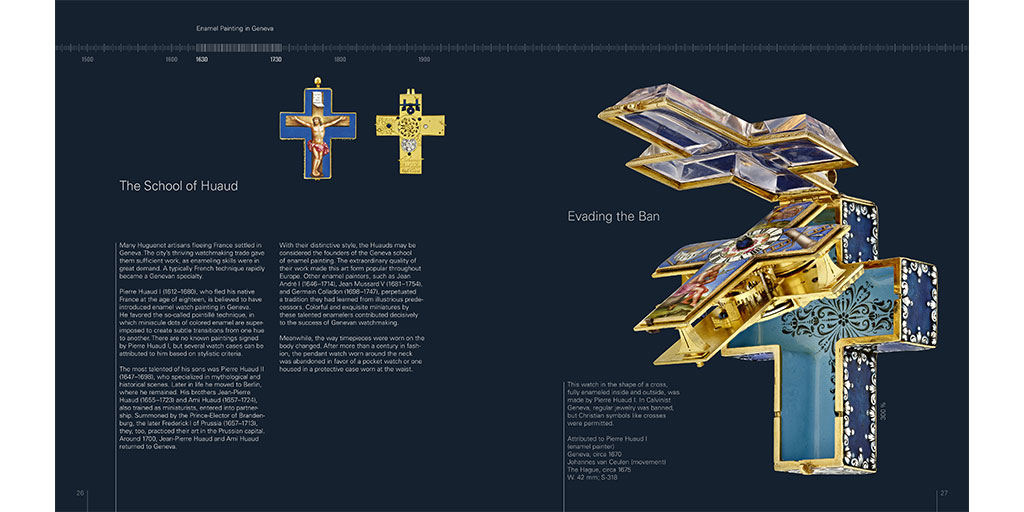
The software merges all these shots into a single photo. The images are so detailed that, when I study the watches, I am able to enlarge the photo almost infinitely, thus providing details you have a hard time seeing on the actual watch. Sometimes I will see details in the photograph and then go back to look more carefully at the physical watch, and suddenly see those details, which I was previously not aware of. To make sure our new books capture these exquisite details, the book designer and the photographer teamed up to find the best angle to look at each piece. A watchmaker on our team was always present to position the watch optimally in front of the lens.
JR: The presentation of the enamels is particularly noteworthy. The quality of the enamel jumps off the page and makes it quite easy to view and appreciate the three dimensions in two dimensions. I especially like the enamels that put in a ‘ribbon’ across the pages so that you can see the story literally unfold.
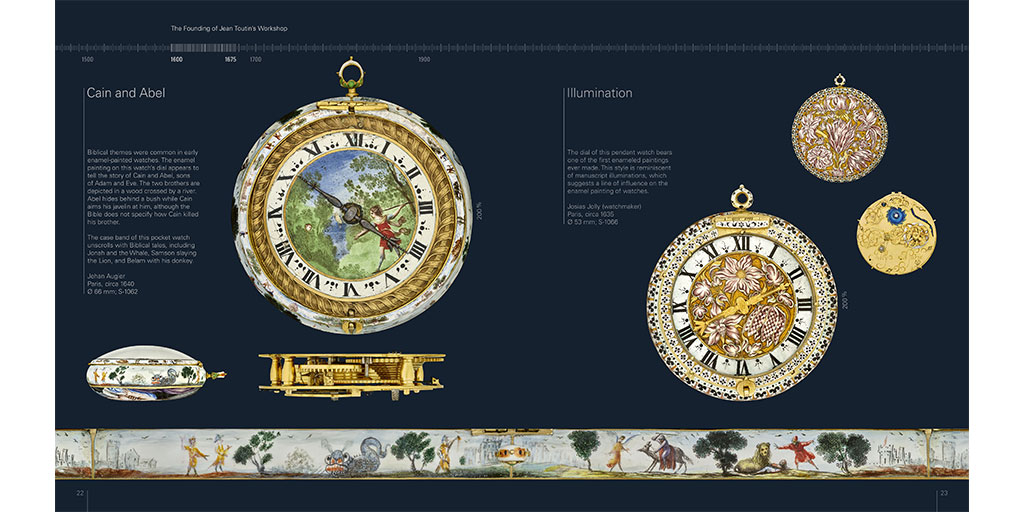
PFR: The Patek Philippe Museum owns the world’s largest collection of enamel-painted watches (a small selection of which are shown in the pages of this book as seen below). Often containing copies of large paintings by great artists of the Renaissance and art periods that followed, these timekeepers are works of art in their own right. The mechanical movements in these watches are impressive but, in most cases, not all that important to horological history. There are many different ways to apply the enamel, from a pure painting on one side and perhaps translucent enamel on the other, covering the guilloche work on the case. The photos make that guilloche work completely visible. The lacquer applied to the images in our books makes it hard to believe that you are not looking at real enamel, rather than images on printed paper.
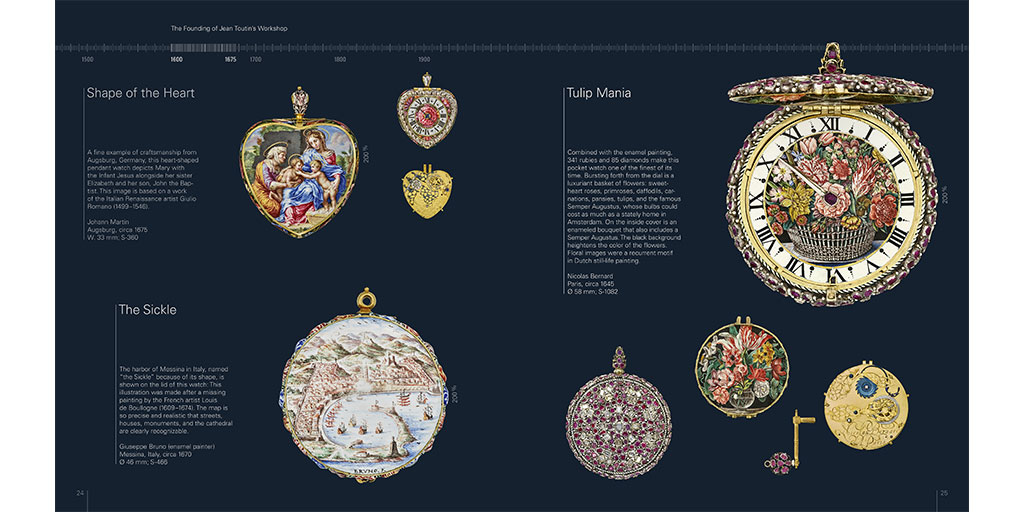
JR: Who was the designer of these books? Can you tell us how you worked with the designer and photographer to put this all together?
PFR: Philippe Stern wanted watches to be the stars of the books, and did not want other images or vintage company advertisements to upstage them, so to say. The book design was the idea of and executed by Birgit Binner. She created a design that brings out the star power of every piece. Each page is unique. None of her design elements is used in a purely decorative way; instead, every one of them is meant to enhance the reader’s understanding of the subject (for example, on the pages below we can clearly see the concept of paired watches for the Chinese market):

The timeline ranges from the years 1500 to 2000, spanning across both volumes and providing each of the forty chapters its proper place in history. For every watch, at least one of its images is presented in actual size, allowing the reader to compare the dimensions of one timepiece with another. If an image is enlarged or reduced by a certain percentage, the exact number is specified next to the image. Our book designer worked closely with me and my whole team to make sure that the resulting photo captures the inner beauty of the watch, that is, the incredible precision of the mechanism. Keywords or short headlines next to the objects guide the readers, firing their fantasies and imaginations. The ultra-high print density allows one to read even tiny movement numbers and makers’ signatures. In this business, minute details count for a lot.
JR: What was Mr. Philippe Stern’s involvement with this project?
PFR: Mr. Stern was fully and passionately engaged: he read every text, commenting on many of them. Particularly for the Patek Philippe Collection, he gave us details that only he would know from steering the company successfully for so many years. Both books show some of the new acquisitions made over the last five years, for instance, the Jost Bürgi clock, engineered more than 400 years ago (see below), or some of the 40 enamel watches we recently acquired from a private collector in England. The books are Philippe Stern’s personal horological walk-through the last five centuries and we are privileged to be able to accompany him.
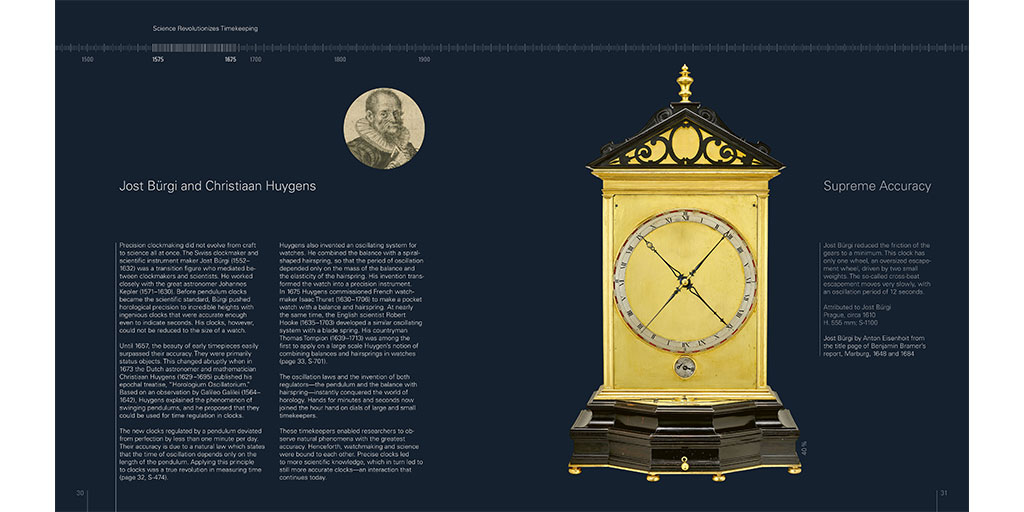
JR: As curator of the museum, you work with the finest watches ever made on a daily basis. What era and style speaks to you most? As a master watchmaker, you understand the complexities of the watches in a way that very few people do. As an art historian, your appreciation of enameling is well documented. What is your favorite pre-1839 enamel? Your favorite Patek Philippe enamel?
PFR: You’re so right: for more than a decade I have been surrounded every day with the best timepieces ever made. Together with my museum team, watchmakers, and art historians, I literally took most watches apart, looked at them through microscopes, studied their mechanisms, and did my best to create a compelling storyline. The labels in the showcases, the audio-tour in the iPad, the major catalogs and finally these two exhibition books present the content in a slightly different way, based on the same source – our magical database. Yet, all these various media I’ve mentioned convey the same above-mentioned key messages.

Regarding the enamels: This craft originated in Blois and Paris in France in the early 17th century. For historical reasons the craftsmen moved to Geneva shortly thereafter. Enamel painting has flourished in Geneva for 400 years, and continues to do so today. Without the intervention of Philippe Stern and his father Henri Stern, the craft of enamel painting on watches would no longer exist. Both Sterns hired enamel painters in the 1970s, when the academic arts school in Geneva stopped educating them. The best of them came to work for Patek Philippe – and suddenly that old craft once again had a future. That is why we have such a large collection of enamel paintings executed by Suzanne Rohr, one of the most prominent of those rescued crafts people (see above). You can clearly see that Patek Philippe is more than a business or normal company; it is a world heritage company, binding together the past, the present and the future.
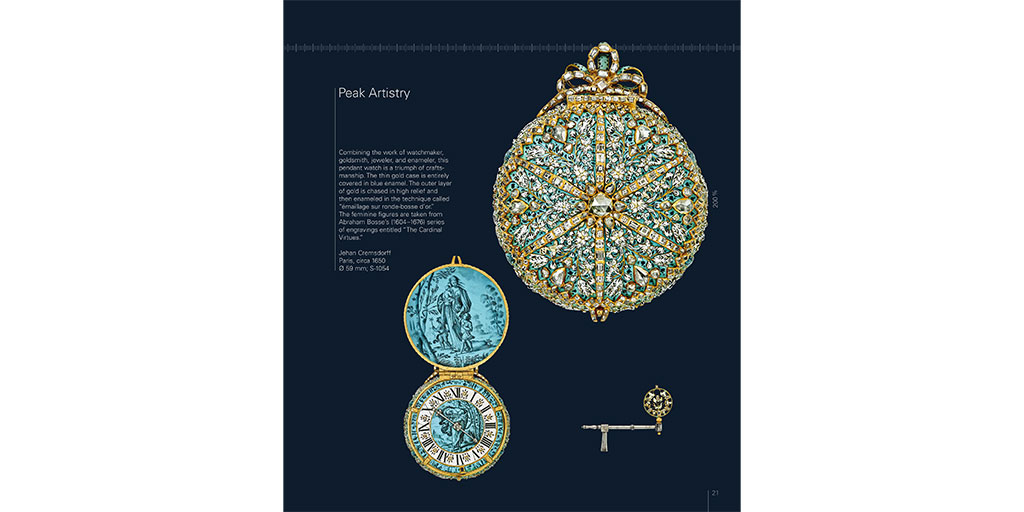
When it comes to the early enamel paintings, my favorite watch has a movement made by the Parisian watchmaker Johan Cremsdorf in the 1640’s (above). For me it is the most beautiful pocket watch ever made, painted by an enamelist of the first generation, working in the lifetimes of Louis XIII and Louis XIV. Now that’s a history!
JR: Within the Patek Philippe pages, can you share with us some of your favorite time-only watches, complicated watches, and clocks?
PFR: We captured the iconic design of Patek Philippe and tried to lay out its evolution, which was heavily influenced by the art nouveau and art deco movements. The popular nicknames we provide next to the watches make it easy for aficionados to find their personal super stars (see below).
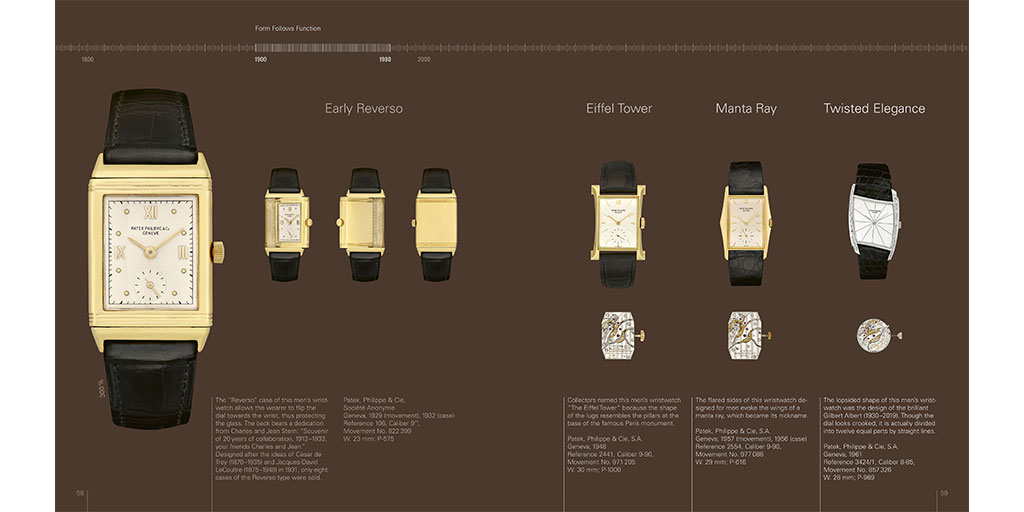
Just as important as Patek Philippe’s powerful design language are the complications. The books illustrate the movements and, in some instances, critical parts of the mechanisms, which are greatly enlarged, beyond what one can barely see with the naked eye. One of the most important timepieces is the now-famous Calibre 89, with more than 1,300 parts (see below).
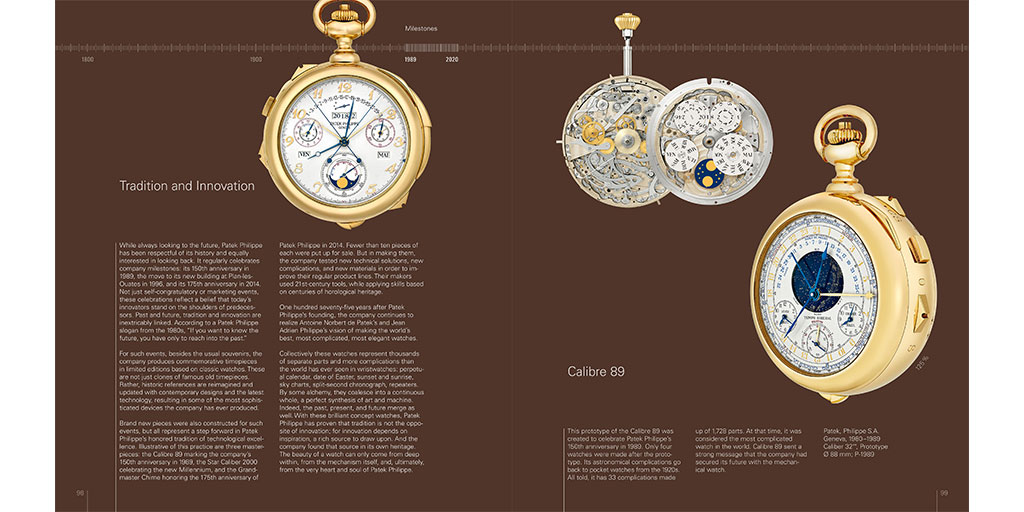
It serves as a hinge between two eras. Before that milestone piece was achieved, Patek Philippe watches amazed us with their level of precision. After the introduction of quartz movements (which resulted in the so-called“quartz crisis”), great precision was almost taken for granted and no longer a selling point. Watches became more and more products of luxury and arts. Following the Calibre 89 came the Star Caliber 2000 as well as the most recent watch in the book, the famous Grandmaster Chime from 2014 (see below).

JR: It is amazing to me how the Patek Philippe Museum is not only about Patek Philippe, for example, the Breguet collection is unmatched. Why is this? Do you see the museum as a protector of world heritage?
PFR: Acquiring and showing watches other than Patek Philippe’s is one of the smartest ideas of our museum’s founder, Philippe Stern. Such historical timepieces provide a frame for appreciating Patek Philippe. The historical watches are the reference points for technological evolution, which often leads to an invention by Patek Philippe. I will give you one example. The great 18th-century French watchmaker Abraham-Louis Breguet invented a watch called “montres à tact” (see below). This watch has a prominent hour hand, positioned on the outer case to allow you to “feel the time” while you keep the watch in your pocket—a nice way not to be “tactless” by glancing at your watch while conversing with others.

When Jean Adrien Philippe published his book “Montre sans clefs” in 1863, he used Breguet’s century-old idea of the montres à tact and added his modern, crown-winding-and-setting mechanism to make this type of watches useable for blind people who found it difficult to manipulate a key (see below). As Philippe Stern always says, “if you want to move to the future you have to consult the past.” That belief is well-understood at the Patek Philippe Museum, and part of the common sense of the Patek Philippe engineers and watchmakers when they create new pieces. I’m gratified that they often start their new creations with a visit to the museum.
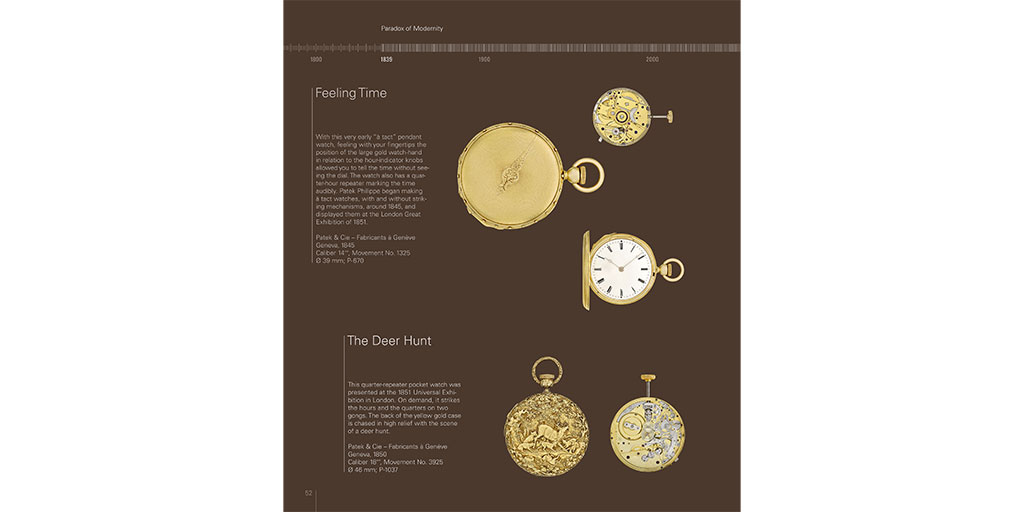
I think it is remarkable that Patek Philippe, a watch company, has its own museum, and especially one that goes deeply into the long history of horology. From that perspective, the museum is in fact an integral part of the company’s business and philosophy.
JR: Innovation in technology is tied to the history of civilization inextricably. What do you think Patek Philippe has specially added to the history of technology since its founding?
PFR: Oh, a great deal — sometimes ground breaking things — but often not even knowing it. When Jean Adrien Philippe came up with one of his latest patents for a pocket watch with independent seconds (see below), he used two independent going trains, each with its own mainspring. They both were wound with one crown. To prevent the breaking of mainsprings by winding them to the very end, one of them was not fixed, but sliding in its barrel. This invention was his, and is only mentioned in the patent with a few words. Many years later that kind of mainspring became essential to self-winding watches. I could continue with stories like this.

JR: The Perfect Watch—can you tell me what makes the perfect watch in your opinion?
PFR: First of all, talking about a “perfect watch” is a kind of vision statement which I developed in order to better describe how I understand what the founders of the company, Patek and Philippe, were thinking. The “perfect watch” is a timekeeper you can put on your wrist or in your pocket that always shows you the correct time, and never needs to be wound or set. Of course, this is impossible, but it gave Mr. Patek and Mr. Philippe and all four generations of leaders of the Stern family the motivation and ability to get closer and closer to that ideal goal. The perpetual (see below) or secular calendar (see below), the mechanism of the world timer, the miniaturization of the quartz watch, the gears for calculating the date of Easter, are just a few examples from Patek Philippe’s portfolio to show the incredible bandwidth of this company, which constantly pushes the envelope of horological technology.
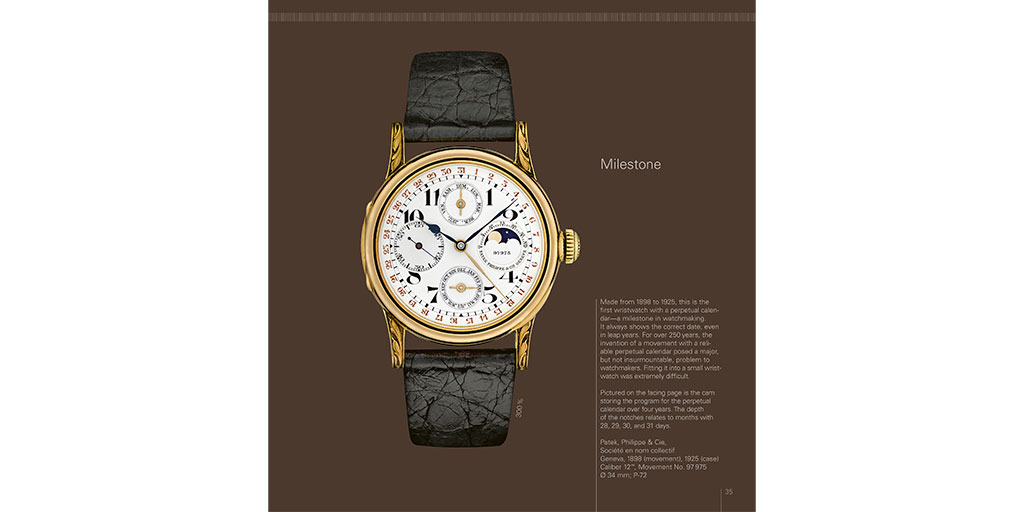

JR: What is the distribution plan for this book?
PFR: The books can be purchased at the Patek Philippe Museum, or ordered shortly through the Patek Philippe website. Books can be pre-ordered online for delivery from December 21 in the USA through Amazon. In addition, our publisher teNeues distributes them around the world, which potentially gives you access to a copy wherever you happen to be.
JR: Thank you, Peter. I hope this interview will inspire, educate and excite the watch collecting community in the same way as the book will!
PFR: Thank you, John. Please communicate to your readers that they are welcome to visit the physical museum. There are so many Patek Philippes, such as prototypes that have never been on the market which can only be seen in Geneva at the Patek Philippe Museum.
Collectability sincerely thanks Peter Friess for his time and kindly allowing us to publish the above excerpts from Treasures from the Patek Philippe Museum: Vol. 1: The Quest for the Perfect Watch (Patek Philippe Collection); Vol. 2: The Emergence of the Portable Timekeeper (Antique Collection).



